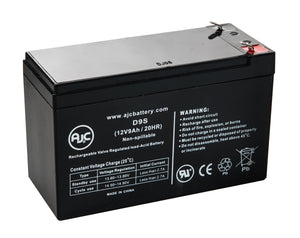Safety Tips for Handling Sealed Lead Acid Batteries
Batteries are a great source of portable energy, and when you handle them carefully and follow basic safety precautions they will power your equipment reliably and without danger.
Sealed lead acid batteries are used in motorcycles, ATVs, boats, RVs, mobility scooters, uninterruptable power supply devices and alarms because they are safe and provide reliable, inexpensive power. Used and disposed of properly, there is little risk of health or safety hazards.
Even so, the materials used to make SLA batteries can be hazardous if they find their way outside of the battery casing. This can happen due to misuse of the battery or from overcharging.
What Is in the Battery?
Lead acid batteries are built with individual cells that contain layers of lead alloy plates in an electrolyte solution. The solution is typically 35% sulfuric acid and 65% water. The lead plates have small amounts of other metals, such as antimony, calcium, tin, and selenium to make them mechanically stronger and to improve their electrical properties. When the acid comes in contact with the lead plates, the chemical reaction results in energy.
Safety Tips
To avoid contacting the toxic materials inside the battery, handle carefully and inspect closely. If the battery looks swollen or is leaking anything, don’t charge it or use it. If it is already installed, turn off the equipment and have the battery removed and disposed of properly.
Follow the manufacturer’s instructions for positioning and installation. While one of the many benefits of SLA batteries is that they can be positioned anywhere, it’s best to have it seated tightly to avoid excessive bumping which could potentially damage the casing.
Always wear protective clothing when handling the battery or working on it or near it. Gloves, eye protection and long sleeves are recommended. If you come in contact with the acid inside the battery, flush the area with large amounts of cool water. Remove any clothing that has spilled acid on them and discard them. If you get acid in your eyes, flush them with warm, running water for at least 30 minutes. If they are still irritated, seek medical attention.
If the battery terminals are exposed, there is a risk of electrical shock, even on disconnected batteries. Don’t touch terminals with metal tools that span the terminals, don’t wear jewelry when working on batteries and never carry a battery by the terminals. Use a strap or cradle designed for that purpose.
We covered charging SLA batteries in a previous tutorial, but remember to follow the instructions and use the correct size and type of charger for your battery. If the battery is charged too quickly or for too long, gas pressure can build up inside the battery causing the release valves in the battery to open and vent toxic gas. If this happens near fire or sparks, an explosion can occur.
SLA batteries are sometimes heavy. Use common safe lifting methods when you need to move the battery. Wear gloves, long sleeves and eye protection, get close and lift with your legs.
When your battery no longer holds a charge and can’t power your device, make sure to dispose of it properly and safely. The best option is to recycle it. Most places that sell SLA batteries also accept them for recycling.
Find Your Replacement Battery
Browse our website to see if we have a match for your replacement battery
Browse Batteries

